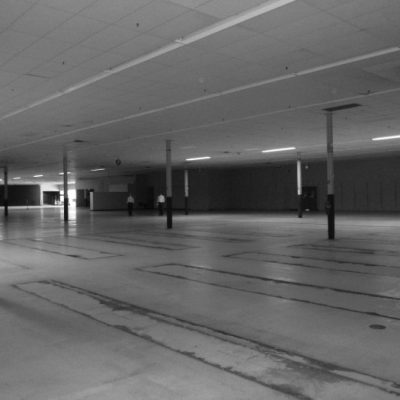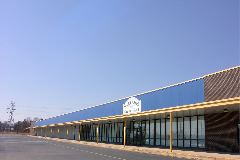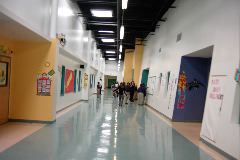Last week we saw an article in the @rivercitynews, discussing the departure of the Burlington Coat Factory from Latonia to Newport. We wanted to continue that conversation and start a discussion about what to do about failing (empty) big box retail malls and strip centers in general, but specifically Latonia Shopping Center. We’ll talk a bit about the history of these malls and quickly get into precedents of redevelopment. We’ll also discuss potential uses within the existing structures, external enhancements to the buildings and parking areas that can make them more appealing and competitive with the renaissance of urban centers and finally improving the connection – both social and physical – to surrounding community and neighborhoods.
You might know that shopping centers were an outgrowth of the increasingly auto-centric culture between the 1950s and 1970s when everyone flocked to the suburbs. Malls were developed centrally within these new population centers, and in keeping with the suburban auto culture, were accessed only by automobile. Anchor tenants (big department stores like Dillards or JC Penney) are a key driver of drawing people in. When the anchor tenants leave or go out of business the rest of the mall generally spirals with it. Some believe the decline of malls seems to have begun in or around 2008 when people started to scorn material goods in favor of experiences after the financial crisis. The growth of the internet, wealth inequality and re-urbanization also contributed to the demise of the shopping mall. Additionally, there has been a shift from high-end mall retail to more value-oriented, discount retailers, which impacts rent structures and limits the ability of Owners to reinvest. Exacerbating the decline, malls that have been vacant awhile are frequently perceived as just being in a bad location.
Since shopping malls were built to accommodate the automobile, they are typically surrounded by a massive concrete parking lot which cuts them off from the surrounding community – essentially creating an island of use in the middle of an ocean of parking. Giant parking lots serve more like a moat than welcoming visitors from the surrounding community. While the mall may not be completely abandoned, empty stores and parking lots contribute to the perception of blight and decline and gives a sense of emptiness and lifelessness to the community. Once a storefront is vacant for an extended period, it begins to be perceived as a place where “retail won’t work” and reestablishing shopping patronage that comes from habit becomes nigh impossible. Current development trends embrace alternative modes of transportation and walkability. With the internet and growth of home delivery services many “drive, and park” retail stores are becoming extinct – for them to survive, we believe that retail must evolve to focus more on people and experiences instead of cars.
If redeveloping the vacant malls were easy, everyone would be doing it. There are many obstacles to redevelopment, some we’ve already mentioned. As the retail culture becomes more pedestrian-oriented, shopping malls are isolated from the surrounding communities by systems built for the automobile, presenting barriers to pedestrian access and poor walkability with little or no physical or psychological connection to adjoining communities. These systems present barriers to pedestrian access. From a design standpoint, malls are inwardly focused with bleak exteriors that do not appeal to a pedestrian on the outside. The experience is inside, which is fine when it’s a regional destination, but not good when you’re drawing from the neighboring community.
Shopping malls are typically owned by people that often have no connection to the local community, and there is a lack of developer incentive to change that course. That ownership is often a publicly traded commodity, who expect returns on their investment - some are waiting for the right time to sell. Properties not tied up with existing leases may be more appealing to investors, but the land value may exceed the income potential of the property, making it difficult to sell. Infrastructure improvements and investment may increase project costs and extend the investment payback period. That’s a lot of complications to overcome to redevelop.
So, enough about the problems! Let’s talk about solutions, ideas of how to reinvigorate the spaces, and how we can get there. While vacant spaces have a negative aesthetic impact, they present huge opportunities for redevelopment. Retail must evolve to compete with the walkable, pedestrian-oriented urban areas. Creative thinking is required to re-establish the social network required for successful redevelopment. How can we re-imagine the suburban experience?
Some of the benefits of empty big box stores and strip malls are that they have high ceilings (called volume), location (accessibility to major thoroughfares), and the spaces are accessible to everyone (everything is usually on one floor). Oftentimes adaptive re-uses do not have the same parking needs, and the expansive parking areas can be a negative (desolate and abandoned) if not planned appropriately. If we help retail evolve to create a destination space again, we can help it achieve something that the internet cannot provide – service and experience. The real in-person social aspect of interaction.
What are we seeing as a trend in use for use of the empty big box stores? Lots of uses are suited to big-box vacancies, mainly due to affordability that is an outcome of the vacancies:
1. Centers that cater to an aging population (boomers) like health centers or mixed-use residential communities that provide everything in one (walkable) location. A great example is the Jackson Medical Mall.
2. Mixed uses that are employed to ensure 24/7 viability - typically including office (daytime), residential and hotel uses (evening). See City Center Bishop Ranch for an another excellent example.
3. National trends are in co-working, micro-housing, lifestyle centers, and urban living.
4. Entrepreneurial users, incubator spaces and co-working spaces seek lower rental thresholds of entry as well as a sense of community absent in the solo work environment. These might include ethnic food and retail; coincidentally this use group is often found in strip malls, taking advantage of the economy of low rent. The lower rent structure presents a low barrier for entry into suburban population centers. Cheaper rents are a model of community rehabilitation (see our gentrification blog here) and is often sought out by these types of tenants. These spaces provide a local and authentic experience sought out by today's consumers. Malls and big boxes provide an advantage of affordability sought by small business entrepreneurs.
An incubator example, and 24 hour use
5. Beyond retail and business other general uses can be satellite community college or vocational campuses, churches, or community center or gathering spaces often missing from the suburbs. Often these types of spaces can be shared between the community and the new uses. The Hickory Hollow Mall is prepping to do just that in Nashville, TN.
6. Call Centers are often ideal tenants for the large wide-open spaces of big-box retail. While call centers are not outwardly impacting the community, they do provide a workforce that could support surrounding in retail and even housing if properly planned.
7. Schools in Buffalo, Laramie and Charlotte take advantage of the open plan that allows flexibility and adaptability of the curriculum that is unencumbered by the existing building structure. For cash strapped school systems, renovation is often more economical than building new.
8. Breweries and Distilleries are a burgeoning use that required loading docks and storage. Many require large exterior areas for parties and patrons.
The key is creating diversity and density of uses that meet local needs and create a connection to the adjacent communities. In all cases, connection to the community – both physical and psychological is very important. Designers are opening the inward focus of the malls to create appeal to the exterior community. Knitting the site back into the community by providing civic life/center frequently absent from suburban development. Ironically, often redevelopment involves introducing street grids to mall sites to restore the urban connection to surrounding neighborhoods, and as with so many parts of our communities, connection to transit is key.
Re-greening parking lots is often a strategy born of reduced parking needs that makes the area more pedestrian-friendly and strengthens the connection to the surrounding community. Community parks, even if a small portion or out lot of the larger development can be an easy first step to developing patron traffic, appeal and community. These spaces can be the first step in attracting new development (i.e. Art Off Pike led to Covington Arts led to Madlot led to Braxton led to Duveneck). Active programming (events) is often employed as a strategy to create a sense of identity, destination, purpose, and experience, attracting consumers to these redeveloped centers.
Meridian Green in Connecticut shows us how we can re-green a parking lot
Designers are already using those things to their advantage when they are redesigning these types of spaces; for example, an empty WalMart building in McAllen, TX got a brand-new lease on life when they turned it into a large community library.
Exterior Before
Exterior After
Interior Before
Interior After
(McAllen Images copyright 99% Invisible)
Or the Charlotte, North Carolina Kmart that was converted to the Sugar Creek Elementary School which took advantage of the circulation and the existing structural grid of the open plan to layout the classroom spaces.
Sugar Creek Before
Sugar Creek After
(Sugar Creek Images copyright Big Box Reuse)
These are all excellent reuses of the big box volume and accessibility.
There are two approaches to redeveloping the Latonia Shopping Center. One is described thoroughly in the Latonia Small Area Study created by Northern Kentucky Area Planning Commission in 2011. That plan demolishes the existing structures entirely, starting over and re-developing site in three phases: first developing the out lots along Winston, then developing the northern half of the site and finally developing the southern half. That plan describes re-establishing, strengthening and enhancing existing roadways and access from adjoining areas and neighborhoods, creating vegetated open space and orienting new buildings to the street both sides of Winston.
But we don’t think it has to be a complete do-over. Another approach might be an interim step of activating the existing site. Changing the environment of the parking lot will be key in attracting new, more vibrant uses. This could be greening the parking lot, redeveloping key out-parcels and reprogramming the existing buildings. Utilizing some portion of the existing site as a transit center may make sense due to the proximity of the site to Covington, Latonia, Fort Wright and I-275. There might be opportunities to create entertainment venues along the loading docks to the rear that face the green space around the radio tower of WCVG like Braxton is doing at the old Remke’s in Ft. Mitchell. There are opportunities to create gateway entrances at both ends of Winston Ave - one at Howard Litzler and one at the historic American Legion Hall. There are also opportunities to redevelop Winston as a “complete street” through the introduction of traffic calming designs such as boulevards, narrowing, bump outs, etc. Additionally, we could strengthen access to Twin Oaks, Bill Cappel Sports Complex and develop a recreational trail/link along Banklick.
What can we do about Latonia? Who owns it? How can we connect it back into the community? What amenities are lacking in the surrounding community of Latonia that could be incorporated there? In addition to addressing the unfriendly nature of the parking lot, should we consider traffic calming on Winston Avenue to encourage a stronger pedestrian connection to surrounding neighborhoods as part of this redevelopment? We don’t think we need to start over. But we do think we can start now.








